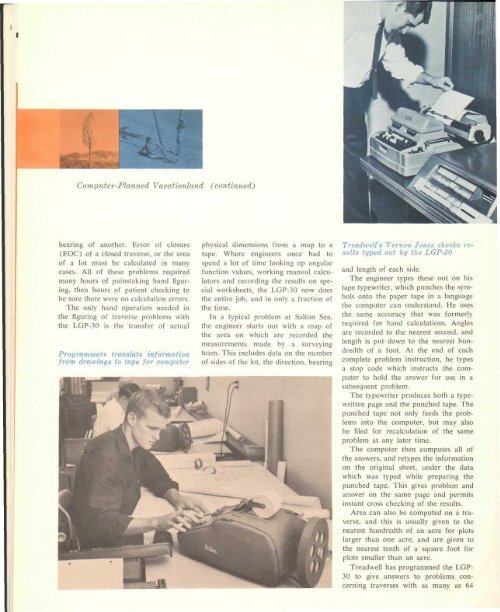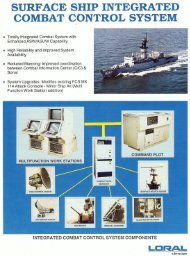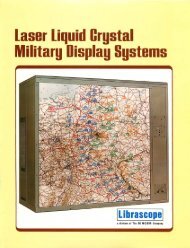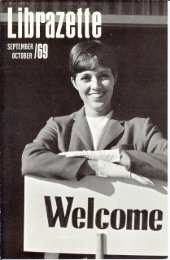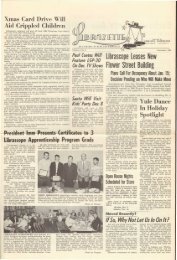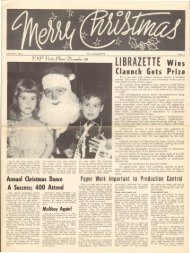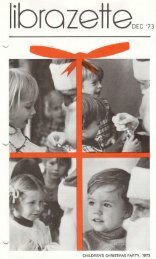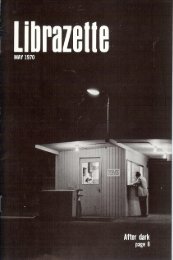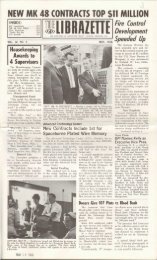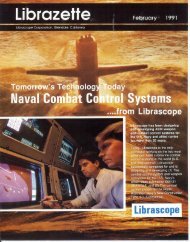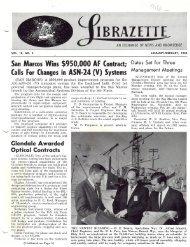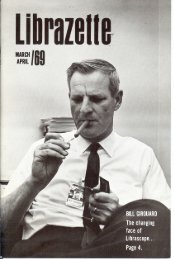Technical Review - Fall 1959. - Librascope Memories
Technical Review - Fall 1959. - Librascope Memories
Technical Review - Fall 1959. - Librascope Memories
Create successful ePaper yourself
Turn your PDF publications into a flip-book with our unique Google optimized e-Paper software.
Computer-Planned Vacationland<br />
(continued)<br />
bearing of another. Error of closure<br />
(EOC) of a closed traverse, or the area<br />
of a lot must be calculated in many<br />
cases. All of these problems required<br />
many hours of painstaking hand figuring,<br />
then hours of patient checking to<br />
be sure there were no calculation errors.<br />
The only hand operation needed in<br />
the figuring of traverse problems with<br />
the LGP-30 is the transfer of actual<br />
Programmers translate information<br />
from drawings to tape for computer<br />
physical dimensions from a map to a<br />
tape. Where engineers once had to<br />
spend a lot of time looking up angular<br />
function values, working manual calculators<br />
and recording the results on special<br />
worksheets, the LGP-30 now does<br />
the entire job, and in only a fraction of<br />
the time.<br />
In a typical problem at Salton Sea,<br />
the engineer starts out with a map of<br />
the area on which are recorded the<br />
measurements made by a surveying<br />
team. This includes data on the number<br />
of sides of the lot, the direction, bearing<br />
Treadwell's Vernon Jones checks results<br />
typed out by the LGP-30<br />
and length of each side.<br />
The engineer types these out on his<br />
tape typewriter, which punches the symbols<br />
onto the paper tape in a language<br />
the computer can understand. He uses<br />
the same accuracy that was formerly<br />
required for hand calculations. Angles<br />
are recorded to the nearest second, and<br />
length is put down to the nearest hundredth<br />
of a foot. At the end of each<br />
complete problem instruction, he types<br />
a stop code which instructs the computer<br />
to hold the answer for use in a<br />
subsequent problem.<br />
The typewriter produces both a typewritten<br />
page and the punched tape. The<br />
punched tape not only feeds the problems<br />
into the computer, but may also<br />
be filed for recalculation of the same<br />
problem at any later time.<br />
The computer then computes all of<br />
the answers, and retypes the information<br />
on the original sheet, under the data<br />
which was typed while preparing the<br />
punched tape. This gives problem and<br />
answer on the same page and permits<br />
instant cross checking of the results.<br />
Area can also be computed on a traverse,<br />
and this is usually given to the<br />
nearest hundredth of an acre for plots<br />
larger than one acre, and are given to<br />
the nearest tenth of a square foot for<br />
plots smaller than an acre.<br />
Treadwell has programmed the LGP-<br />
30 to give answers to problems concerning<br />
traverses with as many as 64


